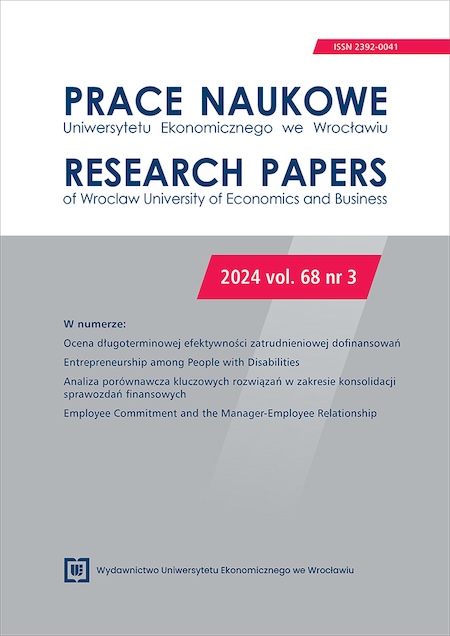Properties of Time Series of Rates of Return on Investments in Non-ferrous Metals
Keywords:
non-ferrous metals, COVID-19 pandemic, war in Ukraine, time series, alternative investmentsAbstract
Aim: The aim of the paper is to identify the properties of time series of rates of return on investments in selected non-ferrous metals, taking into account the current unstable economic and geopolitical situation, as well as to compare the properties of the analysed time series.
Methodology: The article uses selected statistical and econometric methods, financial engineering methods, and time series analyses. The paper presents the development of prices and rates of return of non-ferrous metals (aluminum, tin, zinc, copper, nickel, and lead) in the years 2015-2023, determines the basic statistics of time series and checks the normality and stationarity of empirical distributions.
Results: Investments in copper brought the highest return and investments in lead the lowest. All time series had a positive historical rate of return. Returns on investments in nickel were characterised by the greatest volatility. The distributions of the rates of return on investments in copper and tin were left-sided asymmetric, the other series were right-sided asymmetric. All empirical time series distributions did not coincide with the normal distribution, but they showed stationarity.
Implications and recommendations: People working in the non-ferrous metals sectors and investors should be interested in knowing the ownership of the rates of return on investments in non-ferrous metals. This can help them to forecast prices of non-ferrous metals more accurately and, as a result, to make more optimal trades in the market.
Originality/value: The article verified the properties of the rates of return on investments in non-ferrous metals in view of the high volatility prevailing in the metals market in recent years.
Downloads
References
Akhtaruzzaman, M., Banerjee, A. K., Le, V. i Moussa, F. (2024). Hedging Precious Metals with Impact Investing. International Review of Economics & Finance, (89), 651-664. https://doi.org/10.1016/j.iref.2023.07.047
Bednarz-Okrzyńska, K. (2019). Wpływ koniunktury giełdowej na wyniki modelowania empirycznego rozkładu stóp zwrotu z akcji spółek indeksu WIG20. Wydawnictwo Naukowe Uniwersytetu Szczecińskiego.
Charpentier Poncelet, A., Helbig, C., Loubet, P., Beylot, A., Muller, S., Villeneuve, J., Laratte, B., Thorenz, A., Tuma, A. i Sonnemann, G. (2022). Losses and Lifetimes of Metals in the Economy. Nature Sustainability, 5(8), 717-726. https://doi.org/10.1038/s41893-022-00895-8
Cunado, J., Gabauer, D. i Gupta, R. (2024). Realized Volatility Spillovers between Energy and Metal Markets: A Time-varying Connectedness Approach. Financial Innovation, 10(1), 1-17. https://doi.org/10.1186/s40854-023-00554-7
European Commission, Joint Research Centre, Carrara, S., Bobba, S. i Blagoeva, D. (2023). Supply chain analysis and material demand forecast in strategic technologies and sectors in the EU: a foresight study. Publications Office of the European Union. European Commission, Joint Research Centre. https://data.europa.eu/doi/10.2760/386650
Galán-Gutiérrez, J. A. i Martín-García, R. (2022). Fundamentals vs. Financialization during Extreme Events: From Backwardation to Contango, a Copper Market Analysis during the COVID-19 Pandemic. Mathematics, 10(4), 1-23. https://doi.org/10.3390/math10040559
Ghazani, M. M., Khosravi, R. i Caporin, M. (2023). Analyzing Interconnection among Selected Commodities in the 2008 Global Financial Crisis and the COVID-19 Pandemic. Resources Policy, (80), 1-16. https://doi.org/10.1016/j.resourpol.2022.103157
Herman, S. i Lach, B. (2022). Skutki ekonomiczne restrykcyjnego lockdownu jako strategii walki z pandemią. Prace Naukowe Uniwersytetu Ekonomicznego we Wrocławiu, 66(4), 71-86. https://doi.org/10.15611/pn.2022.4.05
Investing.com. https://pl.investing.com/
Jung, D. S. (2023). Spillover Effects and Connectedness between Oil Futures Markets and Commodity Futures Markets. Journal of System and Management Sciences, 13(1), 620-636. https://doi.org/10.33168/JSMS.2023.0131
Krysicki, W., Bartos, J., Dyczka, W., Królikowska, K. i Wasilewski, M. (2012a). Rachunek prawdopodobieństwa i statystyka matematyczna w zadaniach. Rachunek prawdopodobieństwa, część 1. Wydawnictwo Naukowe PWN.
Krysicki, W., Bartos, J., Dyczka, W., Królikowska, K. i Wasilewski, M. (2012b). Rachunek prawdopodobieństwa i statystyka matematyczna w zadaniach. Statystyka matematyczna, część 2. Wydawnictwo Naukowe PWN.
Osińska, M. (red.). (2007). Ekonometria współczesna. Towarzystwo Naukowe Organizacji i Kierownictwa „Dom Organizatora”.
Ostasiewicz, S., Rusnak, Z. i Siedlecka, U. (2006). Statystyka. Elementy teorii i zadania. Wydawnictwo Akademii Ekonomicznej im. Oskara Langego.
Paulo, A. i Strzelska-Smakowska, B. (2020). Rudy metali nieżelaznych i szlachetnych. Uczelniane Wydawnictwa Naukowo-Dydaktyczne AGH.
Pera, K., Buła, R. i Mitrenga, D. (2014). Modele inwestycyjne. Wydawnictwo C. H. Beck.
Piasecki, K. i Tomasik, E. (2013). Rozkłady stóp zwrotu z instrumentów polskiego rynku kapitałowego. Wydawnictwo edu-Libri.
Strojny, J. (2020). Wektorowe modele autoregresyjne w analizie zależności między produkcją rolną a wymianą zagraniczną towarów rolno-żywnościowych krajów Unii Europejskiej. Difin.
Sun, X., Fang, W., Gao, X., An, S., Wu, T. i Ren, S. (2023). Nonlinear Dynamical Analysis of Metal Futures Price Fluctuations: A Recurrence Quantification Analysis Approach. Applied Economics, 55(10), 1142-1155. https://doi.org/10.1080/00036846.2022.2096864
Syczewska, E. M. (2006). The Phillips Method of Fractional Integration Parameter Estimation and Aggregation of PLN Exchange Rates. Dynamic Econometric Models, (7), 209-220.
Yang, S., Yang, W., Zhang, K. i Hao, Y. (2023). A Novel System Based on Selection Strategy and Ensemble Mode for Non-Ferrous Metal Futures Market Management. Systems, 11(2), 1-33. https://doi.org/10.3390/systems11020055
Zhang, T. i Zeng, S. (2023). Dynamic Comovement and Extreme Risk Spillovers between International Crude oil and China’s Non-Ferrous Metal Futures Market. Resources Policy, (80), 1-20. https://doi.org/10.1016/j.resourpol.2022.103263
Downloads
Published
Issue
Section
Categories
License
Copyright (c) 2024 Paulina Król

This work is licensed under a Creative Commons Attribution-ShareAlike 4.0 International License.
Accepted 2024-06-04
Published 2024-09-24









